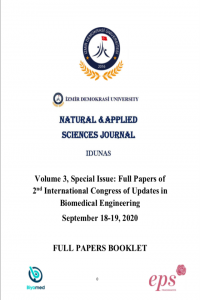Abstract
References
- 1. Andresen, Inger-Lill, Olav Skipnes, Olav Smidsrød, Kjetill Ostgaard, and Per Chr. Hemmer. “Some Biological Functions of Matrix Components in Benthic Algae in Relation to Their Chemistry and the Composition of Seawater.” ACS Symposium Series Cellulose Chemistry and Technology. (1977): 361– 81.
- 2. Paques, Jerome P . “Alginate Nanospheres Prepared by Internal or External Gelation with Nanoparticles.” Microencapsulation and Microspheres for Food Applications. (2015): 39–55.
- 3. Draget, Kurt Ingar, Olav Smidsrød, and Gudmund Skjåk‐Bræk. “Alginates from Algae.” Biopolymers Online. (2002): 807-828
- 4. Shilpa, Anu, S. S. Agrawal, and Alok R. Ray. “Controlled Delivery of Drugs from Alginate Matrix.” Journal of Macromolecular Science, Part C: Polymer Reviews. 43/2 (2003): 187–221.
- 5. Hans, M.l, and A.m Lowman. “Biodegradable Nanoparticles for Drug Delivery and Targeting.” Current Opinion in Solid State and Materials Science. 6/4 (2002): 319–27.
- 6. Matyash, Marina, Florian Despang, Rakesh Mandal, Diccon Fiore, Michael Gelinsky, and Chrysanthy Ikonomidou. “Novel Soft Alginate Hydrogel Strongly Supports Neurite Growth and Protects Neurons Against Oxidative Stress.” Tissue Engineering Part A. 18/1-2 (2012): 55–66.
- 7. Pereira, Leonel, Ana Sousa, Helena Coelho, Ana M. Amado, and Paulo J.a. Ribeiro-Claro. “Use of FTIR, FT-Raman and 13C-NMR Spectroscopy for Identification of Some Seaweed Phycocolloids.” Biomolecular Engineering. 20/4-6 (2003): 223–28.
- 8. Trica, Delattre, Gros, Ursu, Dobre, Djelveh, Michaud, and Oancea. “Extraction and Characterization of Alginate from an Edible Brown Seaweed (Cystoseira Barbata) Harvested in the Romanian Black Sea.” Marine Drugs. 17/ 7 (2019): 405.
Characterization of a 3D Neuronal-Culture Using Alginate Hydrogels and Optimize For Neuronal Survival and Axon Growth
Abstract
Alginate is a polysaccharide that found in the brown algae, the main function of the alginate in the algae is structure-forming like strength and flexibility. Alginate has wide range of uses in textile, food, pharmaceutical, and biomedical industries. It is preferred because of its properties such as biocompatibility, nontoxicity, biodegradability. Alginate chemical properties can be varied by collection time, weather, and the type of algae.
Alginate can be used as a hydrogel because of cross-linking capability with divalent cations. There are two main residues of alginate, mannuronic acid (M) and guluronic acid (G). The ratio of M/G is one of the most important features, if M/G is bigger than 1, hydrogel would be more elastic and if G residues are more than M residues, the hydrogel is become stiffer.
The algae in this study are collected from Tuzla seaside, Istanbul, and alginate extraction is performed. The extracted alginate is used for 3D cell culture. Characterization of the alginate is essential before making it hydrogel by using divalent cations. Before cellular experiments the chemical analysis, purity test, and viscosity of alginate are checked by using Fourier-transform infrared spectroscopy (FTIR),fluorescence spectroscopy, and viscometer. Extracted alginates M/G ratio is found 0.6, there is no fluorescence is observed and the viscosity is 29 mPas. All these results are compared with alginic acid, sodium salt (SigmaAldrich, 180947), and the results are similar with each other. For cellular experiments, the alginic acid, sodium salt (SigmaAldrich, 180947), and extracted alginate are used.
Alginate can be used as a 3D environment for cells, but the neuronal model cells used in this study did not exhibit differentiation, which may be due to these cells not having integrins that recognize and bind the alginate. To improve cellular growth and differentiation in the alginate hydrogel, extracellular matrix (ECM) proteins can be used.
Motor neuron cells (NSC-34) are used for cell encapsulation, the alginate concentration is optimized 1% after trying the concentrations of 0.5%, 1%, 2.2%, 2.5%. Cells are imaged every 24h and after 72nd hour the cells undergo necrosis, and there is observed cellular growth, barely. Non-growth is one of the expected results. To extend the lifetime and the growth of neurons, the collagen is added but the optimization step continues.
The expectations for these experiments are to create an environment for neurons and optimize the alginate hydrogel and collagen. These alginate and alginate-collagen platform can be used for implantation after optimizations and the physical properties are improved.
Keywords
References
- 1. Andresen, Inger-Lill, Olav Skipnes, Olav Smidsrød, Kjetill Ostgaard, and Per Chr. Hemmer. “Some Biological Functions of Matrix Components in Benthic Algae in Relation to Their Chemistry and the Composition of Seawater.” ACS Symposium Series Cellulose Chemistry and Technology. (1977): 361– 81.
- 2. Paques, Jerome P . “Alginate Nanospheres Prepared by Internal or External Gelation with Nanoparticles.” Microencapsulation and Microspheres for Food Applications. (2015): 39–55.
- 3. Draget, Kurt Ingar, Olav Smidsrød, and Gudmund Skjåk‐Bræk. “Alginates from Algae.” Biopolymers Online. (2002): 807-828
- 4. Shilpa, Anu, S. S. Agrawal, and Alok R. Ray. “Controlled Delivery of Drugs from Alginate Matrix.” Journal of Macromolecular Science, Part C: Polymer Reviews. 43/2 (2003): 187–221.
- 5. Hans, M.l, and A.m Lowman. “Biodegradable Nanoparticles for Drug Delivery and Targeting.” Current Opinion in Solid State and Materials Science. 6/4 (2002): 319–27.
- 6. Matyash, Marina, Florian Despang, Rakesh Mandal, Diccon Fiore, Michael Gelinsky, and Chrysanthy Ikonomidou. “Novel Soft Alginate Hydrogel Strongly Supports Neurite Growth and Protects Neurons Against Oxidative Stress.” Tissue Engineering Part A. 18/1-2 (2012): 55–66.
- 7. Pereira, Leonel, Ana Sousa, Helena Coelho, Ana M. Amado, and Paulo J.a. Ribeiro-Claro. “Use of FTIR, FT-Raman and 13C-NMR Spectroscopy for Identification of Some Seaweed Phycocolloids.” Biomolecular Engineering. 20/4-6 (2003): 223–28.
- 8. Trica, Delattre, Gros, Ursu, Dobre, Djelveh, Michaud, and Oancea. “Extraction and Characterization of Alginate from an Edible Brown Seaweed (Cystoseira Barbata) Harvested in the Romanian Black Sea.” Marine Drugs. 17/ 7 (2019): 405.
Details
| Primary Language | English |
|---|---|
| Subjects | Engineering |
| Journal Section | Research Article |
| Authors | |
| Publication Date | January 13, 2021 |
| Published in Issue | Year 2021 Volume: 3 Issue: Special Issue: Full Papers of 2nd International Congress of Updates in Biomedical Engineering |

